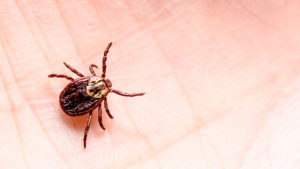It’s Time for a Tick Talk

By: Kathy Hubbard
“You should write about ticks,” a friend of mine said a few weeks ago. “They’re frisky this year.” Then my life-partner found what he thought was one in our bed and put it into a container for me to check out. I’ve never seen one up close, so I did the logical thing. I looked it up on the internet.
It’s amazing. You not only can find a multitude of tick images; you can also watch a video (or six) on how to remove them. You can also find out that in Idaho, we’re home to wood ticks, and they rarely transmit diseases like Lyme disease or Rocky Mountain Spotted Fever. Let’s emphasize, “rarely.”
An Idaho Fish and Game report said, “To reproduce, the female wood tick needs blood. To catch an unsuspecting victim, the tick will climb to the end of a branch and wait for a warm-blooded host to pass by.”
Often that host is a deer, moose, horse, or dog. If you’ve made any one of them a pet, you should check them carefully and regularly. But, today, we’re going to talk about the host being a human.
“Once onboard, ticks look for a place to feed. When a tick bites, it injects anesthetic and anticoagulant, so the carrier doesn’t feel it. They cut the tissue and stick their head under the skin to get to the blood,” IDFG explains.
They tend to like warm, moist places. So, after you’ve been in areas that may have ticks, you should carefully check regions on your body such as under your arms, the back of your knees, your scalp, and your groin. Remember that most of the time, the tick bite doesn’t itch or hurt.
To prevent infection, you should remove the tick as quickly as possible. Mayo Clinic advises you to use fine-tipped forceps or tweezers to grasp the tick as close to your skin as possible.
“Gently pull out the tick using a slow and steady upward motion. Avoid twisting or squeezing the tick. Don’t handle the tick with bare hands. Experts don’t recommend using petroleum jelly, fingernail polish, or a hot match to remove a tick,” Mayo says.
Thoroughly wash the area with soap and warm water, and be sure to wash your hands thoroughly as well. Then apply an antibiotic ointment that you can get over-the-counter at any drug store.
Then, put the tick into a container or place it on a piece of tape. You’re going to hang onto this critter for a few days to make sure you don’t react to the bite. If you do, the medico will want to see what exactly it was that bit you.
If you aren’t able to altogether remove the tick and its head is still in your skin, contact your healthcare provider as quickly as possible. “The longer the tick remains attached to your skin, the greater your risk of getting a disease from it,” Mayo cautions.
Call 911 if you develop a severe headache, difficulty breathing, paralysis, or heart palpitations. These are visible signs of your body having a distressed reaction.
As always, an ounce of prevention is worth a pound of cure. When outdoors, especially in grassy, woody areas, wear a long-sleeved shirt and long pants. Tuck your socks into the hems of your pants and apply a tick repellent for clothing products on your clothes. Put an insect repellent for skin that includes DEET or citronella oil on exposed skin, being careful to avoid your eyes.
Ticks can lurk in your clothes, so as soon as you get home, remove them and, while you’re taking a shower, put the clothes into a hot dryer for at least ten minutes, which will kill the little suckers.
As for your pets, IDFG says, “Pets should be regularly checked for ticks. Outdoorsmen should make a habit of checking for them throughout the summer and fall. To help protect pets, update their flea, and tick collars regularly to ensure good protection, but regular body checks after each trip into the field are still important.”
As it turned out, our critter wasn’t a tick. I hope you have the same luck, but if not, you now know what to do.
Kathy Hubbard is a member of Bonner General Health Foundation Advisory Council. She can be reached at [email protected].
